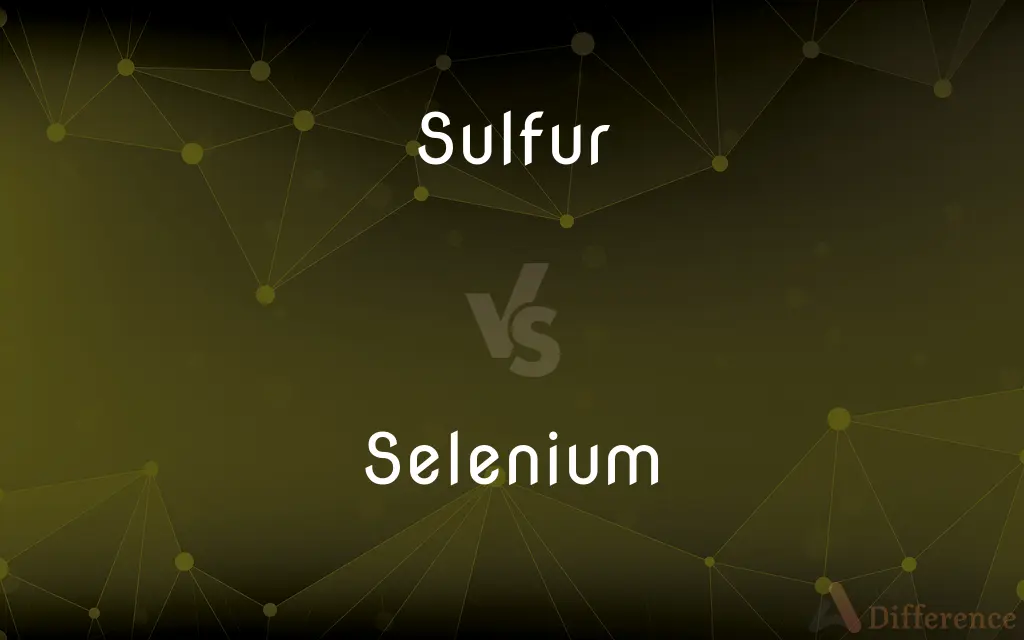Sulfur vs. Selenium — What's the Difference?
By Maham Liaqat & Fiza Rafique — Updated on April 16, 2024
Sulfur is a nonmetallic chemical element primarily used in fertilizers, while selenium is a trace mineral essential for human health.

Difference Between Sulfur and Selenium
Table of Contents
ADVERTISEMENT
Key Differences
Sulfur, with atomic number 16, is abundant in nature and critical for producing sulfuric acid, a key industrial chemical. On the other hand, selenium, atomic number 34, is rarer and vital for synthesizing antioxidants in humans.
Sulfur is primarily obtained from desulfurization of petroleum and gas industries and mining of gypsum and pyrite. Whereas, selenium is mostly recovered from the anode muds produced during the electrolytic refining of copper.
In terms of biological importance, sulfur is a component of amino acids and vitamins. On the other hand, selenium is essential for the proper functioning of enzymes and plays a role in preventing cellular damage.
Sulfur is used in the manufacture of fertilizers, and insecticides, highlighting its role in various industrial applications. Whereas selenium is used in photocopiers, glass production, and as a dietary supplement, reflecting its diverse technological and health-related uses.
Sulfur compounds often have a distinct, foul odor, a characteristic feature in identifying gas leaks. In contrast, selenium compounds are odorless but can be toxic in high concentrations, indicating the need for careful handling.
ADVERTISEMENT
Comparison Chart
Atomic Number
16
34
Common Uses
Fertilizers, chemicals, matches
Dietary supplements, glass, photocopiers
Biological Role
Component of amino acids
Antioxidant enzyme component
Extraction Source
Desulfurization of fossil fuels
Anode muds in copper refining
Hazardous Characteristics
Foul odor in compounds
Toxicity in high doses
Compare with Definitions
Sulfur
An essential element for life, involved in protein synthesis.
Sulfur is a part of the amino acid methionine.
Selenium
A micronutrient essential for antioxidant protection.
Selenium helps combat oxidative stress in the body.
Sulfur
A yellow, nonmetallic element used in chemicals and fertilizers.
Sulfur is critical for synthesizing sulfuric acid.
Selenium
A trace element found in soil, influencing its availability in crops.
Selenium levels in soil affect local diet nutritional quality.
Sulfur
A component in volcanic emissions and hot springs.
Sulfur emissions can be detected by their distinct smell.
Selenium
Found in electronic and photographic applications.
Selenium is used in the toner for photocopiers.
Sulfur
A byproduct of fossil fuel combustion contributing to environmental pollution.
Sulfur dioxide emissions are a concern in urban air quality.
Selenium
Used in the glassmaking industry to decolorize glass.
Selenium compounds give glass a red tint.
Sulfur
Used historically in traditional medicine and rituals.
Sulfur was once used to ward off evil spirits.
Selenium
Vital for thyroid hormone metabolism.
Selenium is necessary for the conversion of T4 to T3.
Sulfur
Sulfur (in British English: sulphur) is a chemical element with the symbol S and atomic number 16. It is abundant, multivalent and nonmetallic.
Selenium
Selenium is a chemical element with the symbol Se and atomic number 34. It is a nonmetal (more rarely considered a metalloid) with properties that are intermediate between the elements above and below in the periodic table, sulfur and tellurium, and also has similarities to arsenic.
Sulfur
Any of various butterflies of the subfamily Coliadinae of the family Pieridae, having yellow or orange wings often marked with black.
Selenium
A nonmetallic element, red in powder form, black in vitreous form, and metallic gray in stable crystalline form, resembling sulfur and found as an impurity in pyrites or obtained as a byproduct of electrolytic copper refining. It is widely used in rectifiers, as a semiconductor, and in xerography. Its photovoltaic and photoconductive actions make it useful in photocells, photographic exposure meters, and solar cells. Atomic number 34; atomic weight 78.96; melting point (gray) 221°C; boiling point (gray) 685°C; specific gravity (gray) 4.79; (vitreous) 4.28; valence 2, 4, or 6. See Periodic Table.
Sulfur
To treat with sulfur or a compound of sulfur.
Selenium
A nonmetallic chemical element (symbol Se) with an atomic number of 34, used mainly in glassmaking and pigments and as a semiconductor.
Sulfur
(uncountable) A chemical element (symbol S) with an atomic number of 16.
Selenium
A single atom of this element.
Sulfur
A yellowish green colour, like that of sulfur.
Selenium
A nonmetallic element of the sulphur group of atomic number 34, analogous to sulphur in its compounds. It is found in small quantities with sulphur and some sulphur ores, and obtained in the free state as a dark reddish powder or crystalline mass, or as a dark metallic-looking substance. It exhibits under the action of light a remarkable variation in electric conductivity, and is used in certain electric apparatus. Symbol Se. Atomic weight 78.96.
Sulfur
Any of various pierid butterflies of the subfamily Coliadinae, especially the sulfur-coloured species.
Selenium
A toxic nonmetallic element related to sulfur and tellurium; occurs in several allotropic forms; a stable gray metallike allotrope conducts electricity better in the light than in the dark and is used in photocells; occurs in sulfide ores (as pyrite)
Sulfur
Of a yellowish green colour, like that of sulfur.
Sulfur
(transitive) To treat with sulfur, or a sulfur compound, especially to preserve or to counter agricultural pests.
Sulfur
An abundant tasteless odorless multivalent nonmetallic element; best known in yellow crystals; occurs in many sulphide and sulphate minerals and even in native form (especially in volcanic regions)
Sulfur
Treat with sulphur in order to preserve;
These dried fruits are sulphured
Common Curiosities
Where is sulfur commonly found?
Sulfur is found in volcanic areas, mineral springs, and as a byproduct in petroleum industries.
How do sulfur and selenium differ in their natural forms?
Sulfur is commonly found in a yellow crystalline solid form, while selenium can appear in several forms, including red and metallic gray.
What is the primary use of sulfur?
Sulfur is primarily used in the manufacture of fertilizers and various chemicals.
What are the dietary sources of selenium?
Selenium is commonly found in nuts, seafood, eggs, and meat.
How does selenium benefit human health?
Selenium is crucial for immune system function and preventing cell damage.
Why is sulfur important in agriculture?
Sulfur is essential for plant growth and is a major component of fertilizers.
Can sulfur and selenium be found together in nature?
They can occur together in sulfide ores, though they are usually found separately.
What are the risks associated with selenium?
Excessive selenium intake can lead to toxicity, with symptoms like hair loss and gastrointestinal disturbances.
Is sulfur considered a pollutant?
Yes, sulfur dioxide, a byproduct of burning fossil fuels, is considered a significant air pollutant.
How are sulfur and selenium extracted?
Sulfur is mainly extracted from fossil fuels and minerals like gypsum, while selenium is recovered from copper refining processes.
What are the historical uses of selenium?
Historically, selenium was used in glassmaking and as a pigment in ceramics.
What role does sulfur play in environmental issues?
Sulfur compounds, such as sulfur dioxide, contribute significantly to acid rain and air pollution.
How is selenium used in industry?
Selenium is used in the electronics industry, particularly in photocopiers and solar cells.
What safety precautions are necessary when handling selenium?
Handling selenium requires precautions to avoid inhalation or ingestion, which can be toxic.
What environmental impact does selenium have?
Selenium can be toxic to wildlife and aquatic systems in high concentrations.
Share Your Discovery

Previous Comparison
Administrate vs. Facilitate
Next Comparison
Dagoba vs. PagodaAuthor Spotlight
Written by
Maham LiaqatCo-written by
Fiza RafiqueFiza Rafique is a skilled content writer at AskDifference.com, where she meticulously refines and enhances written pieces. Drawing from her vast editorial expertise, Fiza ensures clarity, accuracy, and precision in every article. Passionate about language, she continually seeks to elevate the quality of content for readers worldwide.














































